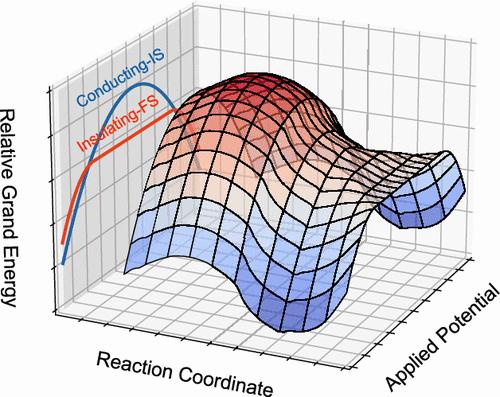大规范电子结构计算在电化学模拟中的实际应用
IF 4.6
2区 化学
Q2 CHEMISTRY, PHYSICAL
引用次数: 0
摘要
带电界面的建模一直是电化学领域的一大挑战。近年来,电子的大规范处理逐渐得到发展,其与密度泛函理论的结合已被广泛用于原子尺度上的电化学过程模拟。在这个视角中,我们的目标是在简短回顾必要的基础知识后讨论这种强大技术的几个实际应用。我们将从基于电容的参数化方法的大正则计算结果开始。如果将不同外加电位下的电极视为不同的材料,则参数化可以看作是一种“二次标度关系”,可以通过数据后分析而不是算法开发来降低总体计算成本。在一个带隙区域内异常的与电位无关的能量曲线的例子之后,我们把话题转向半导体电极。同时,带隙的具体行为也表明,除了反应热力学和动力学外,系统的详细电子结构也可以用电子的大规范处理来很好地描述。本文最后对进一步应用的可能性进行了总结。我们相信,电子结构计算的大规范处理可以极大地丰富我们对电化学环境下基本机制的理解。本文章由计算机程序翻译,如有差异,请以英文原文为准。

Practical Applications of Grand-canonical Electronic Structure Calculations in Electrochemical Simulation
Modeling electrified interfaces has long been a great challenge in electrochemistry. In recent years, the grand-canonical treatment for electrons has gradually been developed, and its combination with density functional theory has been widely used to simulate electrochemical processes on an atomistic scale. In this Perspective, we aim to discuss several practical applications of this powerful technique after a short review of necessary fundamentals. We will begin with capacitor-based parametrization method of grand-canonical calculated results. If considering the electrodes under different applied potentials as different materials, the parametrization can be viewed as a kind of “quadratic scaling relation”, which might reduce the overall computational costs by data postanalysis rather than algorithm development. Following an example of the abnormal potential-independent energetic curve within the bandgap area, we turn the topic to the semiconducting electrodes. Meanwhile, the specific behaviors of the bandgap also indicate that besides the reaction thermodynamics and kinetics, the detailed electronic structure of the system can also be well described by the grand-canonical treatment on electrons. Several possibilities for further applications are proposed correspondingly and summarized at the end of paper. We believe that the grand-canonical treatment for electronic structure calculations can greatly enrich our understanding of the fundamental mechanisms under electrochemical environments.
求助全文
通过发布文献求助,成功后即可免费获取论文全文。
去求助
来源期刊

The Journal of Physical Chemistry Letters
CHEMISTRY, PHYSICAL-NANOSCIENCE & NANOTECHNOLOGY
CiteScore
9.60
自引率
7.00%
发文量
1519
审稿时长
1.6 months
期刊介绍:
The Journal of Physical Chemistry (JPC) Letters is devoted to reporting new and original experimental and theoretical basic research of interest to physical chemists, biophysical chemists, chemical physicists, physicists, material scientists, and engineers. An important criterion for acceptance is that the paper reports a significant scientific advance and/or physical insight such that rapid publication is essential. Two issues of JPC Letters are published each month.
 求助内容:
求助内容: 应助结果提醒方式:
应助结果提醒方式:


